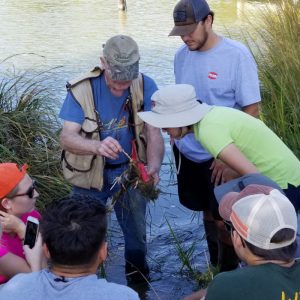
All the world seems to be blooming as we march into April, which naturally causes our thoughts to turn to plants—and the business of plants.
Environmental Concern, Inc. is one of the region’s foremost authorities on native plants and habitat restoration. Founded in 1972 on San Domingo Creek in St. Michaels, this 501(c)3 public not-for-profit corporation employs 25 people, including interns and seasonal workers. Its mission is to improve water quality by creating, restoring, and conserving wetlands, living shorelines, and other natural habitats through education and outreach, propagation of native plant species, and professional design and installation.
Suzanne Pittenger-Slear, president of Environmental Concern, took time from her busy schedule to give us some insight into the corporation and what makes it so successful after nearly 50 years in business.
TW: How and why did you start this business?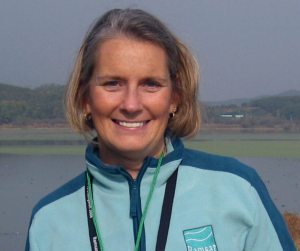
S P-S: Environmental Concern Inc. was founded by Dr. Edgar Garbisch, a tenured professor in organic chemistry at the University of Minnesota. While on a sabbatical, he decided to investigate the untried concepts of marsh (a type of wetland) restoration after observing a dramatic disappearance of wetlands along Eastern Shore waterways. The experiment took several months, and the outcome changed his life and the lives of the many professionals who worked at EC over the last five decades.
Working with a staff of graduate assistants and part-time workers, EC moved on to full-scale experimentation, re-vegetating deteriorated marshes with plants grown from seed in the EC Native Plant Nursery, the first of its kind in the nation.
Over the next two decades, EC created/restored 200 salt marshes, and after several years of experiment and field research, developed marsh restoration protocols. These protocols, refined by years of trial and error, were shared with the Maryland Department of the Environment and U.S. Army Corp of Engineers. Eventually, the soft (or vegetated) shoreline, commonly referred to as the Living Shoreline, a method developed by EC’s professionals, was embraced by state regulators and promoted as the preferred method of shoreline stabilization.
TW: Why are you located in St. Michaels?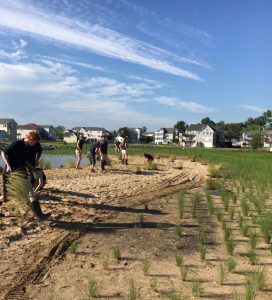
S P-S: Dr. Garbisch donated his waterfront retirement property to EC in the early 70’s. Over the years, EC’s campus has grown from two greenhouses and one small office to a three-acre Native Plant Nursery; a Wetland Education Center, teaching teachers, students and professionals about the functions and benefits of wetlands; and a Wetland Restoration division, offering survey, design, permitting, planning, monitoring, and construction services.
TW: How did COVID-19 impact this business?
S P-S: We are considered essential workers (agriculture), therefore our staff worked through the COVID-19 pandemic. All employees, with the exception of three office staff members who worked remotely, worked every day. I was so proud of our staff. They followed COVID-19 policies and procedures every day, without a complaint or objection. It has been a long year for everyone who worked outside their homes during the pandemic.
Our plant sales were steady throughout the year. Customers were spending time in their gardens and using their garden habitats as a refuge from the daily challenges of the pandemic.
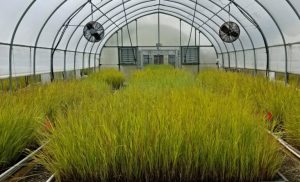 TW: Will you have a plant sale this year?
TW: Will you have a plant sale this year?
S P-S: YES! We are very excited about our sale this year. The public may place an order anytime during the growing season. Our current availability is listed on the retail page under the nursery tab. In 2021, we added 20 native plant species to our catalog.
Customers must choose from the available inventory, and email nursery-sales@wetland.org to place their order with Anne Sindermann, EC’s Nursery Sales Coordinator. Our traditional sale “under the tent” on EC’s campus will be back next spring! Find out more about spring native plant availability here. https://wetland.org/retail/
TW: Are you still on the Critical Area Commission or any other commissions?
S P-S: I was appointed by Governor Hogan to serve on the Critical Area Commission in 2016. I was honored to serve a four-year term as the ‘Eastern Shore Member-At-Large’ (2016-2020). My term ended in May 2020.
Currently, I serve as one of the U.S. NGO (non-governmental organization) liaisons to the Tri-Lateral (U.S., Canada and Mexico) Committee for Wildlife and Ecosystem Conservation. The Trilateral Committee facilitates and enhances cooperation and coordination among the wildlife agencies of the three nations in projects and programs for the conservation and management of wildlife, plants, biological diversity, and ecosystems. In 2019, I traveled with our vice president of restoration to British Columbia, Canada, to attend the meeting. We presented EC’s Mid-Atlantic Monarch Initiative and Seed Stewards for Monarchs program to the Executive Committee for approval by the Tri-Lateral.
TW: How has interest in your products and services changed and grown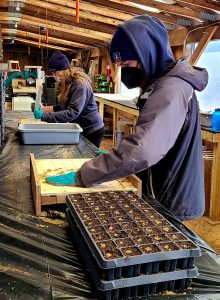 since 1972?
since 1972?
S P-S: People are much more aware of the benefits and functions of native plants. We have seen a remarkable increase in the public’s knowledge about the importance of crucial habitat for threatened and endangered species and all creatures whose survival depends on the nesting, food and protection provided by natural habitat. Our native plant sales continue to increase each year.
Shoreline restoration is becoming an increasingly important strategy for combating coastal habitat loss and maintaining ecosystem services. The term Living Shoreline is now commonly used to describe the vegetative approach to restoring eroding shorelines. As homeowners increase their knowledge about Living Shorelines, we have seen an increase in requests to protect eroding shorelines using vegetation.
TW: Environmental Concern is classified as a nonprofit organization, but you also have a nursery business that sells native plants.
S P-S: All of EC’s operations fall under the non-profit status. EC does not have a for-profit operation. EC’s native plant nursery supplies plants for EC’s projects and sells to the wholesale and retail community. Excess revenue from nursery sales helps fund EC’s education and outreach initiatives. Our annual spring and fall Native Plant Sales are two of our largest community fundraising events.
TW: Tell us about the educational and outreach programs you offer.
S P-S: EC offers various educational opportunities and resources including special programs, workshops, events, and academic experiences that both engage and educate the public about current Chesapeake Bay Watershed resources and issues. Educational services are also provided through print media and include the From Seeds to Living Shorelines newsletter, informational brochures, and pamphlets.
TW: Do you have new products, services, or programs on tap for the near future?
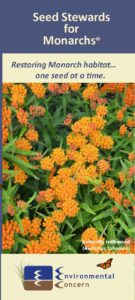 S P-S: One of our new programs is the Eastern Shore Seed Stewards (ESSS) initiative. This program is an extension of the Seed Stewards for Monarchs program, founded in 2018. EC is educating the community about growing native plants, plant identification, and native plant seed harvesting. Seed Stewards collect seeds to propagate and grow in their gardens and donate a percentage of their seeds to EC. The goal of the program is to increase natural habitat for birds, bees, butterflies, and all native species. Seeds must be collected from true native plants and labeled with the location collected, date collected, and species name. We offer Seed Stewards a discount during plant sales, an ESSS garden habitat sign, and free entrance to events.
S P-S: One of our new programs is the Eastern Shore Seed Stewards (ESSS) initiative. This program is an extension of the Seed Stewards for Monarchs program, founded in 2018. EC is educating the community about growing native plants, plant identification, and native plant seed harvesting. Seed Stewards collect seeds to propagate and grow in their gardens and donate a percentage of their seeds to EC. The goal of the program is to increase natural habitat for birds, bees, butterflies, and all native species. Seeds must be collected from true native plants and labeled with the location collected, date collected, and species name. We offer Seed Stewards a discount during plant sales, an ESSS garden habitat sign, and free entrance to events.
Our new activity in 2021 is Garden with a Purpose! Plant for wildlife and quality of life. Gardens are places to plant and play, find peace and tranquility, and enjoy wildlife. During the pandemic, backyard gardening became a new activity for some and a reason to expand an existing garden for others. There was a dramatic increase in retail native plant sales in 2020. We are excited about the increase in enthusiasm for native species and the knowledge that our customers have about the benefits of planting native species.
EC’s gardening with a purpose mission asks you to look at your garden as more than a beautiful flowering landscape to observe and enjoy. Gardening provides an opportunity to educate your family, friends, and neighbors about the importance of incorporating native plants into your landscape. Sharing native plant seeds with a neighborhood group or with the Eastern Shore Seed Stewards is an opportunity to increase critical habitat. Choose species that invite songbirds, butterflies and bees, and other wildlife to visit your garden to find nourishment, a safe place to build a nest, and protection from predators. Follow our suggestions throughout the season to find your purpose in the garden this year.
TW: Look into the future and share your hopes and dreams for the Eastern Shore.
S P-S: Our EC employees hope to see more vegetation on shorelines instead of rock and bulkheads, which have no wildlife or water quality benefits. If you live on the Eastern Shore, you are surrounded by water. Water is part of our daily lives. We love to recreate on or by the water. Our quality of life depends on clean water to go boating and to swim, kayak, paddle board, fish, hunt, sail, and canoe.
We all need to do our part to keep pollution from flowing into the tributaries of the Chesapeake Bay. Native plants take up pollution, slow the flow of storm water and sediment into our waterways, provide important habitat for wildlife, and protect the bay.